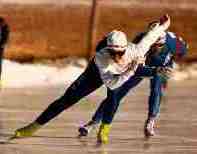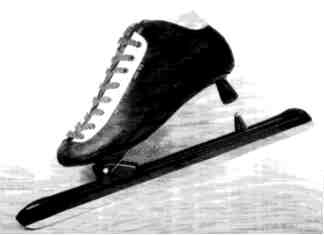![]()
THE NEW
DUTCH "SLAPSKATES": Will They Revolutionize Speed Skating
Technique?
Stephen Seiler, Faculty of Health and Sport, Agder College. Kristiansand, Norway.
|
|
THE NEW
DUTCH "SLAPSKATES": Will They Revolutionize Speed Skating
Technique?
|
|
|
Stephen Seiler, Faculty of Health and Sport, Agder College. Kristiansand, Norway. |
Speed skating is a sport that's been around for centuries. Perhaps its beginnings were on the frozen canals of Holland where it was an efficient winter transportation mode. The remarkably high velocity achieved by speed skaters, and their lateral, gliding push-off technique, was the subject of scientific inquiry as early as the 15th century (Da Vinci, 1488). Despite this lengthy history, little has changed in the technique over hundreds of years. Is speed skating technique optimal? Given the tradition of speed skating in the Netherlands, it shouldn't be surprising that a Dutch sport scientist has taken up this question. Dr Gerrit Jan van Ingen Schenau has sought to optimize speed skating training and technique for years by investigating and modeling the motion of not only speed skaters, but also sprinters, jumpers, and even four-legged animals (Ingen Schenau and Bobbert, 1993) in motion. The results of his integrated, open minded approach may revolutionize speed skating.

Speed skating is elegant in its combination of speed, balance and power. Its peculiarity comes from the interplay between aerodynamic and biomechanical constraints on the one hand, and physiological power and efficiency on the other. Well trained speed skaters consume 5-10% less oxygen during maximal skating than during maximal cycling. When skating and running are compared, the differences swell to 10-20%. Two major explanations have been isolated. First, the aerodynamic crouch position limits peak VO2 compared to skating in a more upright position, presumably owing to impaired muscle flow (Rundell, 1996). More importantly, skaters cannot fully utilize their leg muscles during skating. They are taught to push from the heel and suppress normal plantar flexion in order to reduce friction between the skate and the ice at the end of the push-off.
When analyzing the kinematics and kinetics of the skating push off, Dr Ingen Schenau discovered that not only does this technique functionally eliminate the work of the plantar flexors, it also limits the work done by the more powerful knee extensors. The skater's priority of suppressing plantar flexion causes the skate to lose contact with the ice long before full knee extension. Other investigators have even demonstrated the long-term impact of this technique on force-velocity characteristics of the quadriceps muscle. During high velocity isokinetic testing, elite speed skaters produce markedly greater torque than controls during all phases of knee extension except near full extension, where they are not different (Rajala et al., 1991). If skaters were to extend the ankle (plantar flex) during push-off, they would increase friction, and even drive the tip of the skate into the ice, disturbing balance. As long as speed skates are speed skates, that is the trade-off. Speed skaters give up available power and/or more optimal distribution of muscular workload in order to minimize speed sapping friction.
Enter a New Skate
Besides detailed examinations of the kinematics and physiology of speed skating (for example, van Ingen Schenau et al., 1983; Geijsel et al.., 1987), Ingen Schenau and colleagues turned to biomechanical analyses of unconstrained leg extensions such as in jumping, sprinting, and running to determine the timing and impact of plantar flexion in leg power development (Ingen Schenau, 1989; Ingen Schenau et al.., 1994).
 The result was a new prototype skate that permitted
the shoe to rotate around a hinge connecting the shoe and the skate
blade (Ingen Schenau et al.., 1996). In keeping with how the
foot moves relative to the ground in running and jumping, the hinge
was placed over the metatarso-phalangeal joints. Now it was possible,
in theory at least, for the skier to use more complete knee
extension, plus plantar flexion, while maintaining a horizontal blade
in contact with the ice. Since this new skate was intended to allow
the skater to "slap on" an extra plantar flexion at the end of the
push off, they christened it the "slapskate."
The result was a new prototype skate that permitted
the shoe to rotate around a hinge connecting the shoe and the skate
blade (Ingen Schenau et al.., 1996). In keeping with how the
foot moves relative to the ground in running and jumping, the hinge
was placed over the metatarso-phalangeal joints. Now it was possible,
in theory at least, for the skier to use more complete knee
extension, plus plantar flexion, while maintaining a horizontal blade
in contact with the ice. Since this new skate was intended to allow
the skater to "slap on" an extra plantar flexion at the end of the
push off, they christened it the "slapskate."
Does Theory Translate Into More Speed?
As an initial test, van Ingen Schenau's group employed skaters from the pool of junior skating talent in the Netherlands. Eleven junior skaters (14-18 y) agreed to switch to the slapskates for the 94/95 season. Their performance progression was compared with 72 "normal" skaters in the same region by using the official ranking lists of the Royal Dutch Speed Skating Association. Comparing seasonal results, the slapskaters improved their performances by an average of 6.2%, compared to 2.5% for the normal skaters. Moreover, while the highest regional rankings for the new slapskaters in the previous season had been 36, 11, and 8th in respective age groups, slapskaters led all three lists by the end of the test season. Two of these three went on to win the Dutch national all-around championships for their age-group. From on analysis of individual events, it appeared that slapskates had a relatively greater impact on distance performances than sprint performances. The non-linear power-velocity relationship that applies to overcoming air friction may explain this difference. Overall the data left little doubt that slapskates were positively impacting performance.
Slapskates Reach the International Level
In 1996/97, slapskates have emerged on the international elite skating scene. The transition to slapskates is by no means complete, far from it. Top skaters with years of ingrained motor patterns don't jump over to a radical technique overnight, especially in mid-season. But the success of individual skaters, primarily Dutch, who have made the transition has convinced others to try them. In Norway, opinions are mixed. After watching (from behind) Dutchman Bob de Jong slapskated to an impressive 13:51 10,000-m outdoors during a falling snow (slow conditions), Norway's top distance man, Kjell Storelid, was amazed at both de Jong's performance and the slapskates. "I will try the new slapskates... There is no doubt that they will revolutionize speed skating." Meanwhile, Norwegian national team trainer Havard Sletten was more critical. "Slap skates have the biggest impact on skaters with technical faults. On the men's side the problem has been to find sufficiently strong slapskates. We hope that problem is now solved." German female star Gunda Neiman reacted in another way entirely after losing to another young slapskater from the Netherlands, Toni de Jong. She claimed the skates were illegal and should be outlawed. That won't happen. The skates are fully accepted by the International Speed Skating Federation.
Initial Resistance, Adaptation, Refinement
So, we find ourselves at a familiar cross roads. We saw it during the skating revolution in cross-country skiing, and the emergence of the V-technique in ski jumping. Some athletes transition quickly and profit with a season or two of dominance. Other athletes resist the radical change, and temporarily lose ground. But, in the end, the ultimate laboratory of international competition will decide if the change is positive. If it is, the athletes will all finally adapt, coaching methods will change from international elite level down, and the sport will never look back.
Usually the new ideas come from the athletes. Sport scientists often find themselves in a forensic mode: they try to understand "why" without asking "what if?" The work of van Ingen Schenau, de Koning and colleagues from the Netherlands is an exciting example of sport scientists in a proactive mode. Their comparative and integrative approach over the last decade has sparked positive change in a sport that, technically speaking, has been at an evolutionary standstill for generations. Whether you are a fan of speed skating or not, their approach merits a closer look. Think you have an even better idea? Feel free, but don't expect to get rich: the idea of a hinged skate was patented 70 years ago. Sometimes even good ideas take a while to catch on.
Feb 17. Gunda
Neiman, the German skater who initially called for slapskates to be
banned, may have a new opinion now. She made the switch and now this
weekend (2-13 to 2-16) she won the distance all-around world title,
setting a new WR for combined performance. The bronze medalist Toni
de Jong was also a slapskater. I am not sure about the silver
medalist. On the men's side, one Norwegian skater made the switch and
took 14 seconds off his PR in the 10 k, another made the switch and
got worse. He tried to switch over just before worlds and didn't have
time to adapt his technique.
Feb 20. I have
just received an email message from Jos de
Koning detailing the background to the development of slapskates.
Seiler, K. S. (1997). The new Dutch "slapskates": will they revolutionize speed skating? Sportscience News, (Mar-Apr), http://www.sportsci.org/news/9703/slapskat.htm.
Da Vinci, L. Manuscript B. N.2037 2b (1488-1489). The literary works of Leonardo Da Vinci, Vol 2. Compiled and edited from the original manuscripts by J.P. Richter. New York: Phaidon Publishers, 1970.
Geijsel, J., Bomhoff, J., Van Velzen, G., & Van Ingen Schenau, G. J. (1984). Bicycle ergometry and speed skating performance. International. Journal of Sports Medicine, 5, 241-245.
Ingen Schenau, G. J. Van, De Groot, G., &. Hollander A. P. (1983). Some technical, physiological and anthropometric aspects of speed skating. European Journal of Applied Physiology, 57, 6-9.
Ingen Schenau, G. J. Van & Bobbert, M. F. (1993). On the global design of the hindlimb of quadrupeds. Acta Anatomica, 146, 103-108.
Ingen Schenau, G. J. Van, De Koning, J. J., & De Groot, G. (1994). Optimization in sprinting performance in running, cycling and speed skating. Sports Medicine, 17, 259-275.
Ingen Schenau, G.J. Van, De Groot, G., Scheurs, A. W., & De Koning, J .J. (1996). A new skate allowing powerful plantar flexions improves performance. Medicine and Science in Sports and Exercise, 28, 531-535.
Rajala, G. M., Neumann, D. A., Foster, C., & Jensen, R. H. (1994). Quadriceps muscle performance in male speed skaters. Journal of Strength and Conditioning Research, 8(1), 48-52.
Rundell, K. W. (1996). Compromised oxygen uptake in speed skaters
during treadmill in-line skating. Medicine and Science in Sports
and Exercise, 28, 120-127.
newseditor=AT=sportsci.org · webmaster=AT=sportsci.org · Homepage
· Copyright
©1997